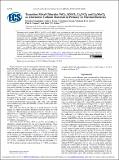Files in this item
Transition metal chlorides NiCl2, KNiCl3, Li6VCl8 and Li2MnCl4 as alternative cathode materials in primary Li thermal batteries
Item metadata
| dc.contributor.author | Giagloglou, Kyriakos | |
| dc.contributor.author | Payne, Julia L. | |
| dc.contributor.author | Crouch, Christina | |
| dc.contributor.author | Gover, Richard K. B. | |
| dc.contributor.author | Connor, Paul A. | |
| dc.contributor.author | Irvine, John T. S. | |
| dc.date.accessioned | 2018-11-16T10:30:13Z | |
| dc.date.available | 2018-11-16T10:30:13Z | |
| dc.date.issued | 2018-11-14 | |
| dc.identifier | 256486807 | |
| dc.identifier | 06191301-1550-41bb-a5c2-a8abcd76a80f | |
| dc.identifier | 85067459303 | |
| dc.identifier | 000450190100001 | |
| dc.identifier.citation | Giagloglou , K , Payne , J L , Crouch , C , Gover , R K B , Connor , P A & Irvine , J T S 2018 , ' Transition metal chlorides NiCl 2 , KNiCl 3 , Li 6 VCl 8 and Li 2 MnCl 4 as alternative cathode materials in primary Li thermal batteries ' , Journal of The Electrochemical Society , vol. 165 , no. 14 , pp. A3510-A3516 . https://doi.org/10.1149/2.1231814jes | en |
| dc.identifier.issn | 0013-4651 | |
| dc.identifier.other | ORCID: /0000-0002-1492-7590/work/60427198 | |
| dc.identifier.other | ORCID: /0000-0003-3324-6018/work/60888222 | |
| dc.identifier.other | ORCID: /0000-0002-8394-3359/work/68280687 | |
| dc.identifier.uri | https://hdl.handle.net/10023/16485 | |
| dc.description | Special thanks to AWE Plc for their support and funding for this work. The authors would also like to acknowledge the EPSRC Platform Grant EP/K015540/1 and the Royal Society Wolfson Merit Award WRMA 2012/R2. | en |
| dc.description.abstract | Transition metal chlorides KNiCl3, Li6VCl8 and Li2MnCl4 were synthesized by solid state reaction in sealed quartz tubes and investigated as candidate cathode materials along with NiCl2 in Li thermal batteries. The structure and morphology were studied and electrochemical properties probed at high temperatures (400°C–500°C) against Li13Si4 by galvanostatic discharge and galvanostatic intermittent titration technique (GITT). All the transition metal chlorides reduced to metal and the products of the discharge mechanism were confirmed by powder X-ray diffraction. NiCl2 was tested at 500°C and a capacity of 360 mAhg−1 was achieved. KNiCl3 was tested at different current densities from 15 mA/cm2 to 75 mA/cm2 and a high voltage profile 2.30V was achieved at 425°C with a capacity of 262 mAhg−1. Li6VCl8 was tested at 500°C and a 1.80V voltage plateau at a current density of 7.5 mA/cm2 was achieved with a capacity of 145 mAhg−1. Li2MnCl4 was tested at the same current density at 400°C and a capacity of 254 mAhg−1 was achieved. These transition metal chlorides exhibit higher voltage against Li13Si4 and, hence, provide more specific power compared to the well-known metal disulfides MS2 (M = Fe, Co, Ni) and may be promising cathode materials for Li thermal batteries. | |
| dc.format.extent | 1635229 | |
| dc.language.iso | eng | |
| dc.relation.ispartof | Journal of The Electrochemical Society | en |
| dc.subject | NiCl2 | en |
| dc.subject | KNiCl3 | en |
| dc.subject | Li2MnCl4 | en |
| dc.subject | Cathode | en |
| dc.subject | Li thermal battery | en |
| dc.subject | Discharge at high temperature | en |
| dc.subject | QD Chemistry | en |
| dc.subject | NDAS | en |
| dc.subject.lcc | QD | en |
| dc.title | Transition metal chlorides NiCl2, KNiCl3, Li6VCl8 and Li2MnCl4 as alternative cathode materials in primary Li thermal batteries | en |
| dc.type | Journal article | en |
| dc.contributor.sponsor | EPSRC | en |
| dc.contributor.sponsor | The Royal Society | en |
| dc.contributor.institution | University of St Andrews. School of Chemistry | en |
| dc.contributor.institution | University of St Andrews. St Andrews Sustainability Institute | en |
| dc.contributor.institution | University of St Andrews. EaSTCHEM | en |
| dc.identifier.doi | 10.1149/2.1231814jes | |
| dc.description.status | Peer reviewed | en |
| dc.identifier.grantnumber | EP/K015540/1 | en |
| dc.identifier.grantnumber | WRMA 2012/R2 | en |
This item appears in the following Collection(s)
Items in the St Andrews Research Repository are protected by copyright, with all rights reserved, unless otherwise indicated.

